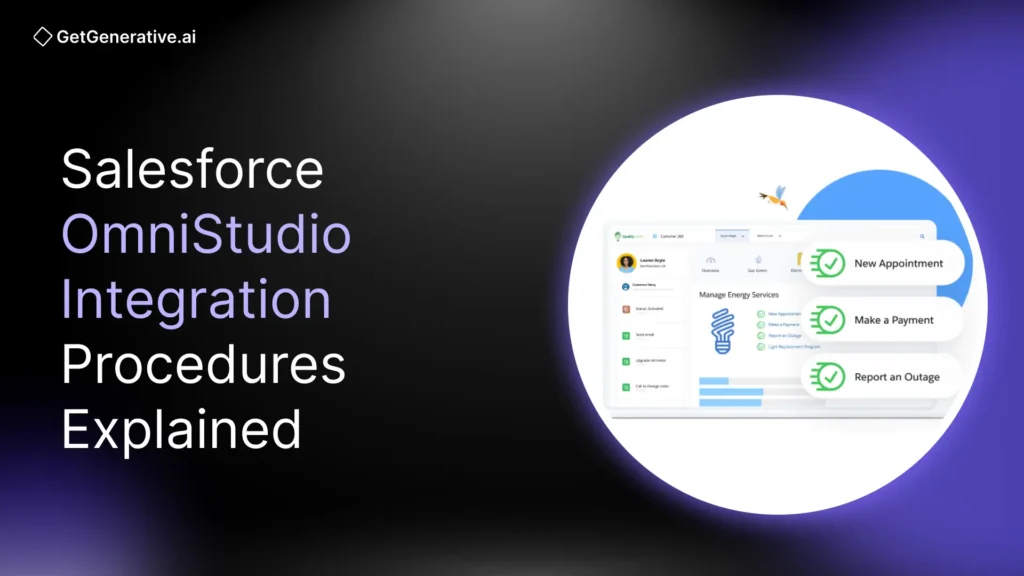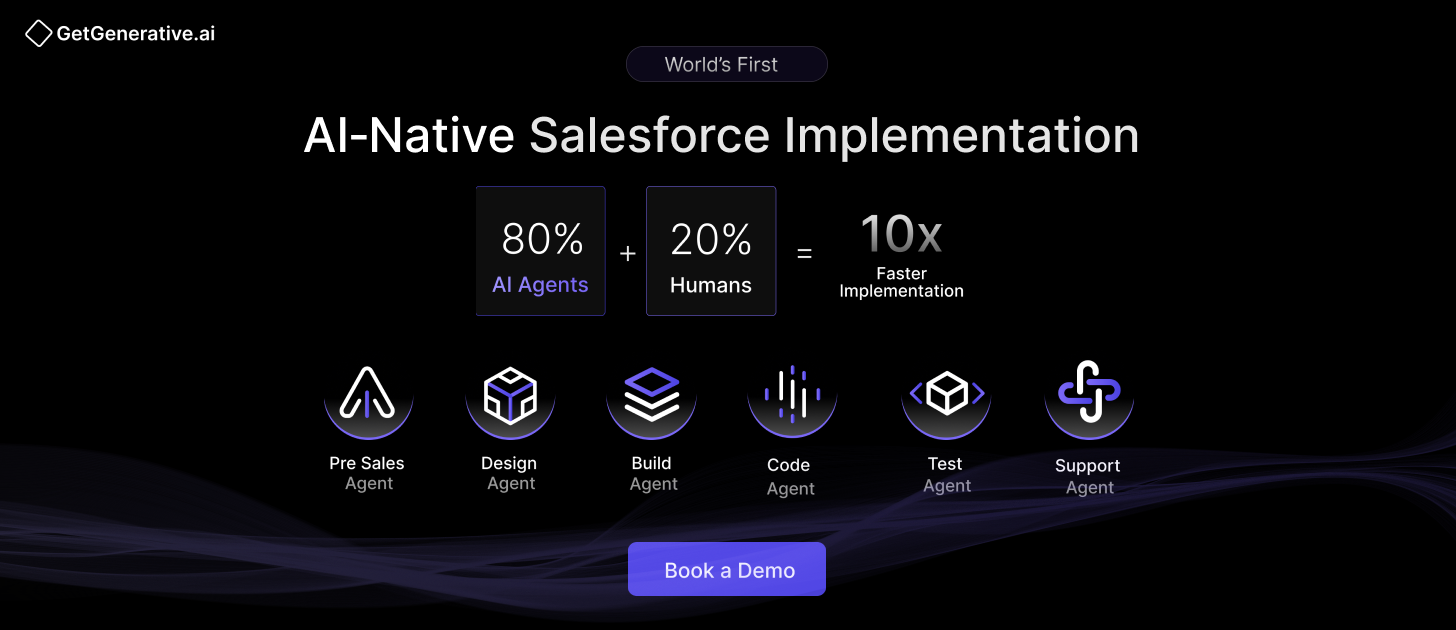Salesforce OmniStudio Integration Procedures Explained
As businesses seek industry-specific solutions that can bridge data silos, automate workflows, and accelerate digital transformation, Salesforce OmniStudio Integration Procedures have emerged as a cornerstone of success.
Unlike traditional integration methods that often suffer from latency, scalability, and governance challenges, these declarative, server-side processes allow enterprises to orchestrate complex integrations with efficiency, scalability, and security.
With the global enterprise data integration market projected to reach $47.60 billion by 2034 at a CAGR of 12.06%, and organizations realizing up to 295% ROI within three years from advanced integration platforms, mastering OmniStudio Integration Procedures is now a strategic necessity.
This guide provides both the technical depth and strategic insights needed to leverage Integration Procedures for maximum business value. Let’s get started!
What Are OmniStudio Integration Procedures?
Architectural Excellence in Server-Side Processing
OmniStudio Integration Procedures transform how enterprises approach integration by running multiple actions in a single server call. This server-side processing eliminates the inefficiencies of traditional client-server models, reducing round-trip latency by 30–50%.
Beyond performance, the server-side architecture enforces Salesforce’s security and governance frameworks, ensuring enterprise-grade compliance while still supporting highly complex business logic. Enterprises gain both speed and trust — a rare combination in integration design.
Core Capabilities and Business Value
OmniStudio Integration Procedures support a wide spectrum of enterprise use cases, from data transformation to real-time orchestration. Key capabilities include:
- Advanced Data Orchestration: They unify data from Salesforce objects, external APIs, and legacy systems, delivering 35–45% higher developer productivity compared to custom coding.
- Real-Time Processing: Unlike batch ETL processes, they enable instant responses to business events — critical for industries like telecom and finance that require real-time decision-making.
- Microservices-Ready: Built on Salesforce’s microservices architecture, they align with the 30% of new applications expected to adopt composable designs by 2027, enabling modular, future-proof enterprise systems.
Enterprise Implementation Strategies
Migration from Legacy Systems
Enterprises shifting from Vlocity OmniStudio to the standard Salesforce OmniStudio platform must plan migrations carefully. The OmniStudio Migration Tool facilitates metadata transfers (DataRaptors, FlexCards, Integration Procedures, OmniScripts) to standard objects.
A typical migration follows three phases:
- Preparation – Renaming components and trial migrations in dev environments. For large enterprises, this phase may span 6–9 months.
- Execution – Migrating active components with minimal downtime. Best-practice implementations report migrations completing within 72-hour maintenance windows.
- Validation & Testing – Verifying migrated procedures to ensure full functionality in the new standard runtime.
Deployment and DevOps Excellence
Enterprise deployments require robust DevOps practices. Two approaches dominate:
- Salesforce CLI – Ideal for version-controlled environments, ensuring precise alignment between source and target orgs.
- OmniStudio Build Tool – Best for managing complex dependencies, as it automatically includes required components in deployments.
Leading organizations implement multi-environment pipelines — development → staging → production — with automated testing at every stage, ensuring stability and agility.
Also Read – Getting Started with Salesforce OmniStudio: A Complete Beginner’s Guide
Performance Optimization and Best Practices
Architectural Design Principles
Enterprises that maximize ROI from Integration Procedures consistently follow proven design strategies:
- Modular Architecture – Breaking complex processes into reusable components simplifies troubleshooting and enables horizontal scaling.
- Caching – Applied to frequently accessed but rarely updated data, caching improves performance by 40–60%, provided cache invalidation is well-managed.
- Response Action Optimization – Trimming payloads to return only what’s necessary reduces transfer volume by 25–35%, enhancing both performance and user experience.
Asynchronous Processing Strategies
OmniStudio Integration Procedures provide flexible execution modes suited to diverse workloads:
- Future Execution – Ideal for bulk data processing that doesn’t require immediate responses.
- Fire and Forget – Used when OmniScripts must invoke Integration Procedures instantly without waiting.
- Non-Blocking Execution – Allows background execution while users continue interacting with the system, essential for customer-facing processes.
Security, Governance, and Compliance
Enterprise-Grade Security
Integration Procedures align with Salesforce’s security model to ensure safe data handling. Critical practices include:
- Field-Level Security – Enforcing data access rules across all Data Mappers.
- Data Encryption Compliance – Verifying permissions before decrypting fields, crucial for GDPR and HIPAA compliance.
- Granular Access Controls – Using sharing settings, permission sets, and custom permissions to balance flexibility with security.
Regulatory Compliance
With regulations tightening worldwide, Integration Procedures must support robust compliance:
- Data Protection – Built-in objects for consent management across GDPR, CASL, and others.
- Audit Trails – Documenting data transformations and system interactions for forensic analysis.
- Data Classification – Applying metadata-based classification to ensure sensitive data is handled appropriately.
Also Read – How to Deploy OmniStudio Components in Salesforce: Step-by-Step Guide
Return on Investment and Business Impact
Financial Performance Metrics
Enterprises adopting OmniStudio Integration Procedures report measurable and significant ROI:
- Developer Productivity – Declarative development boosts productivity by 35–45%, reducing dependency on custom code and accelerating delivery timelines.
- Operational Efficiency – Complex data processes run 25–30% faster, enabling businesses to make decisions more quickly and improve responsiveness.
- Lower Maintenance Costs – Declarative procedures cut integration maintenance costs by 40–50% within 18 months, as they require fewer specialized resources compared to custom-coded integrations.
Strategic Business Value
Beyond financial metrics, Integration Procedures provide competitive advantages that align with broader enterprise objectives:
- Faster Digital Transformation – Organizations experience 60% faster time-to-market for new digital initiatives compared to traditional methods.
- Scalability Without Complexity – Modular design supports millions of daily transactions without performance issues.
- Innovation Enablement – With less time spent on legacy integration upkeep, teams can reallocate resources to innovation, customer experience, and competitive differentiation.
Industry-Specific Applications
Financial Services
Integration Procedures power real-time risk assessments, regulatory reporting, and customer onboarding automation. Their ability to handle complex data orchestration with security and compliance ensures seamless operations in a highly regulated sector.
Healthcare and Life Sciences
By connecting Electronic Health Records (EHRs) with Salesforce Health Cloud, Integration Procedures enable unified patient journeys while maintaining HIPAA and regional compliance. Real-time orchestration supports proactive care management and better patient outcomes.
Manufacturing and Supply Chain
Manufacturers use Integration Procedures to integrate IoT sensors with Salesforce Manufacturing Cloud, driving predictive maintenance and supply chain optimization. Real-time event handling helps enterprises respond instantly to production issues, reducing downtime and costs.
Also Read – Best AI Tools for Salesforce Proposal Generation
Future Considerations and Strategic Planning
Technology Evolution
The roadmap for Integration Procedures aligns with broader enterprise technology trends:
- AI-Powered Integration – Incorporating AI-driven orchestration and data transformation improves predictive analytics accuracy by 40%.
- Expanded Cloud Support – Enhanced capabilities for hybrid and multi-cloud architectures ensure seamless enterprise connectivity.
- Low-Code Democratization – Increasing support for citizen developers allows business users to build integrations without compromising on governance or performance.
Competitive Positioning
While Salesforce leads the CRM market, enterprises must evaluate Integration Procedures against alternatives. For organizations seeking scalability, security, and deep Salesforce alignment, Integration Procedures deliver unique competitive advantages — especially in industries requiring regulatory compliance, real-time decision-making, and large-scale orchestration.
Conclusion
In a world where agility, compliance, and innovation define market leaders, Salesforce OmniStudio Integration Procedures are more than a technical solution — they are a strategic enabler of enterprise success.
At GetGenerative.ai, we’ve reimagined Salesforce implementation—built from the ground up with AI at the core. This isn’t legacy delivery with AI added on. It’s a faster, smarter, AI-native approach powered by our proprietary platform.
👉 Explore our Salesforce AI consulting services




